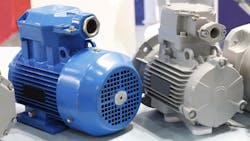Processing Q&A: Realizing energy savings for motors and drives
Keeping motors and drives running efficiently is a major priority for process manufacturers. It is imperative not just for a company’s bottom line, but for investors and regulators as well. Processing recently connected with John Dirks, OEM segment manager for manufacturing, assembly and material handling at Rockwell Automation, to discuss best practices in achieving energy savings as well as the major trends occurring with motors and drives in the processing sector
Q: What are the top factors that companies consider today when evaluating motors and drives for process applications?
A: Energy efficiency is a high priority. Certainly, it’s always been a consideration because energy usage is a top production cost. But today, pressures to improve environmental performance are coming from everywhere – customers, investors, governments – and that’s put a renewed focus on energy efficiency. At the same time, technology advances in today’s motors and drives can help reduce energy usage like never before.
Safety of course is always important. Process operators want to be safe and compliant. But more and more companies are also realizing safety and productivity don’t need to be at odds with each other. Modern drives with capabilities like safety functionalities give you ways to operate in a safe manner while staying as productive as possible.
Process operators are also looking for ways to make their operations more resilient as they deal with challenges like skills and labor shortages. Certainly, having access to data from motors and drives can help the people in a process operation make better decisions. But the use of artificial intelligence (AI) in drives is also helping optimize processes and reduce burdens on workers.
Q: How can today’s motors and drives help process operators reduce their energy usage and be more sustainable?
A: It begins with choosing higher-efficiency technologies. Many companies today, for example, are choosing IE4 permanent magnet motors because they’re inherently more energy efficient than traditional AC induction motors.
Choosing the right motor control option is also crucial. Some companies continue to use across-the-line starters, partly because that’s what they’ve always used but also because starters have historically had a lower price point than variable frequency drives (VFDs). But in the last decade, VFD prices have come down to the point where they’re on parity with the cost of a starter.
Now, with the large cost gap between starters and VFDs all but gone, VFDs are more accessible. What does that mean from an energy-savings standpoint? An across-the-line starter takes on energy at the full rating of a motor every time, which is inefficient because it’s simply not required for most applications. With a VFD, you can ramp up a motor only as quickly as you need to, allowing you to use energy more efficiently.
Data from VFDs can also help you better understand and improve your energy usage. For instance, you can see if drives are consuming energy when they’re not being used to make product. You can see if they’re working harder than usual, which could be a sign that there’s an underlying mechanical issue that needs to be addressed. Or you can identify when your operations use the most energy so you can run your most energy-intensive processes during off-peak demand hours.
What do process operators need to do to get this energy data from their VFDs?
In the past, getting energy data from VFDs would have required adding sensors and writing custom code. But today, special coding called “energy objects” is available in some control systems to make energy data from VFDs and other devices instantly available without requiring any special coding. This essentially turns VFDs into smart energy meters. You just need to use a compatible controller and software with your VFD.
Q: Can you share examples of the types of energy savings that customers are seeing with modern motors and drives?
A: A major beer brand decided to replace the induction motor in one of its production facilities after learning about the energy savings that permanent magnet motors can deliver. Along with the permanent magnet motor, the company installed a low-voltage VFD for motor control. The new solution delivered improved efficiency to help the company realize a 40% reduction in energy usage.
In another case, a chemical producer in Europe wanted to have greater control of the boiler plant at one of its production facilities. The boilers’ airflow was only basically controlled using three old synchronous motors. Because the motors weren’t connected to drives, they continuously worked at full load.
The plant switched to VFDs that can be used to soft start large motors to limit inrush current or for speed control of multiple motors. This has helped the chemical producer reduce electricity consumption by 20%. Soft-start capabilities and speed control have also reduced stresses on equipment to help extend their operating life and reduce maintenance.
Q: How are process operators using drives to achieve safe and productive operations?
A: By incorporating safety features into the design of their machinery, process operators can help their people work safely while optimizing productivity at the same time. One way they’re doing this is by using drives with built-in safety functions.
The most popular safety function sought on drives today is safe torque off. With this function, the drive removes rotational power from a motor when a safety command is received, while the drive itself sits in a “safe state.” This prevents the motor from unexpectedly restarting. Once the safety issue is addressed, a worker can clear the fault and the drive is instantaneously ready to go.
Safe torque off can achieve safety requirements up to SIL 3 and PLe Cat 3. It can also reduce downtime by avoiding lengthy restarts and help reduce wear from such restarts. And by putting safety in the drive instead of requiring separate safety components, it can help simplify machine designs and improve machine reliability.
Q: What are some ways that motor and drive technology can ease the jobs of workers?
A: With today’s tight labor market, process operators are looking for all the help they can get from their machines and equipment to ease workers’ jobs.
For example, a strained workforce that already has enough on its plate shouldn’t need to constantly make sure the drives in their process operation are staying within their set points or limitations to avoid trips or faults. The good news for them is that’s a job that a VFD with built-in AI can now take on. Not only can the AI continually monitor the drive to make sure it stays within its normal operating parameters, but it can also automatically adjust the drive to smooth out the issue. And it can alert workers to the issue, so they have enough time to address the issue before it becomes a production problem.
Opportunities like this to use technology advances to save time and effort, and get in front of potential problems, will only become more vital in the months and years ahead as process operators look for new ways of working to put their workforce challenges behind them.


